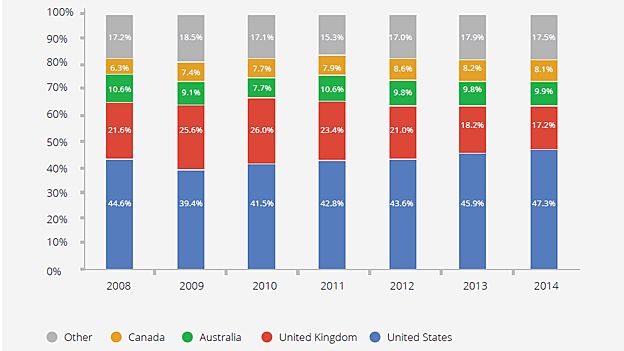
For today’s students, it must seem like a distant and primitive era – but finding information about universities used to depend either on visiting the campus or else getting a copy of the prospectus.
These printed listings of courses and requirements were usually put together with all the creative panache of a telephone directory.
The stilted photos of groups of students in idyllic campus scene became such a cliche they were known as “three under a tree”.
Fast-forward several decades and the dodgy 1970s and 1980s fashion choices might have gone, but universities are trying even harder to attract the attention of students, particularly overseas students.
The global overseas student market has more than doubled since 2000, making it a lucrative and highly competitive battleground for potential recruits.
In the UK alone, overseas students are worth £7bn per year. Many postgraduate courses have a majority of non-UK students, making their financial viability dependent on overseas fees.
Contents
Online searching
The university website is the modern prospectus – and the battle for students is taking place online.
Google has revealed data about the top destinations for where people are searching for university information, when looking at countries outside their own location.
| Google 2014: Share of international education queries | |
|---|---|
| United States | 35.4% |
| United Kingdom | 26% |
| Canada | 8% |
| Australia | 6.2% |
| Netherlands | 2.4% |
| Germany | 2.2% |
| India | 1.6% |
| Sweden | 1.4% |
| China | 1.2% |
| New Zealand | 1.2% |
| Other | 14%+ |
Based on Google’s internal search data for 2014, universities in the US get more searches from abroad than any other country, 35% of the total, matching the position of the US as the world’s biggest market for overseas students.
The UK is the second biggest destination for overseas students and it is also in second place in terms of the amount of searches, with 26%.
But perhaps signalling a shake-up in the market, in third place in Google searches for overseas universities is Canada, with 8%.
 Image copyrightThinkstock
Image copyrightThinkstockAccording to Unesco figures, Canada is the eighth biggest market for overseas students, but it has big ambitions. Canada has increased overseas student numbers by more than 80% in a decade, and it has a strategy for a further increase.
According to these international education queries, Canada comes ahead of Australia, with 6%, while the Netherlands, with 2.4%, has overtaken Germany, 2.2%.
And while China is the biggest sender of students overseas, the search data suggests it holds much less interest as a destination.
Global market
The search data highlights the growing globalisation of higher education. In 2008, 37% of searches related to UK universities were from overseas. By 2014, that had risen to 46%. If the trend continues, most of the people looking at UK universities courses will be outside the country.
But the search data includes a warning about how much demand can fall.
 Image copyrightGoogle
Image copyrightGoogleIndia is second only to China in demand for overseas education.
But from 2010 to 2014, the proportion of searches from India about UK universities fell every year.
In 2010, 26% of university searches from Indian students were about the UK. By 2014, that had reduced to 17%.
This matches a slump in the number of Indian students coming to the UK, which the Google report interprets as a response to the “negative rhetoric” around student visas in the UK.
The winners were the US and Canada. In 2009, 39% of overseas university searches from India were aimed at US universities. That had risen to more than 47% by 2014, and this interest has been reflected in a growth in actual student numbers.
More stories from the BBC’s Knowledge economy series looking at education from a global perspective and how to get in touch
The search data also shows how quickly attitudes can change. The proportion of searches from India about universities in Australia fell by more than a quarter between 2008 and 2010. This followed violent attacks on Indian students in Australia in 2009, which sparked protests in India.
The search data also includes some broader “query trends”. Searching for online learning has climbed sharply since 2011. But global searches for 121 “traditional UK universities” declined between 2013 and 2014.
Switching to mobile
Such search patterns are highly significant in this multi-billion business.
And the New York-based World Education Services (WES), which specialises in the international student market, says universities are having to chase to keep up with the changing technology used by young students.
 Image copyrightThinkstock
Image copyrightThinkstockThis is the mobile phone generation, and Rahul Choudaha, from WES, says an analysis of students applying to study in the US suggested most had used smartphones in the inquiry and application process.
And it raises questions about whether universities are able to distil themselves into a mobile-friendly format.
There is also a strong trend towards students wanting to engage with universities through social media, which is seen as an important influence on decision making.
Gordon Slaven, head of higher education at the British Council, which promotes UK education, says this is an “incredibly competitive market” and universities cannot wait for students to come and find them.
“The institutions must reach out to the student, increasingly online. Our research tells us that the student experience is a key influence,” he says.
“How current students present their life on campus online now plays a vital role in how prospective students will view and make a decision on where they should study.”
[Source:- bbc news]
